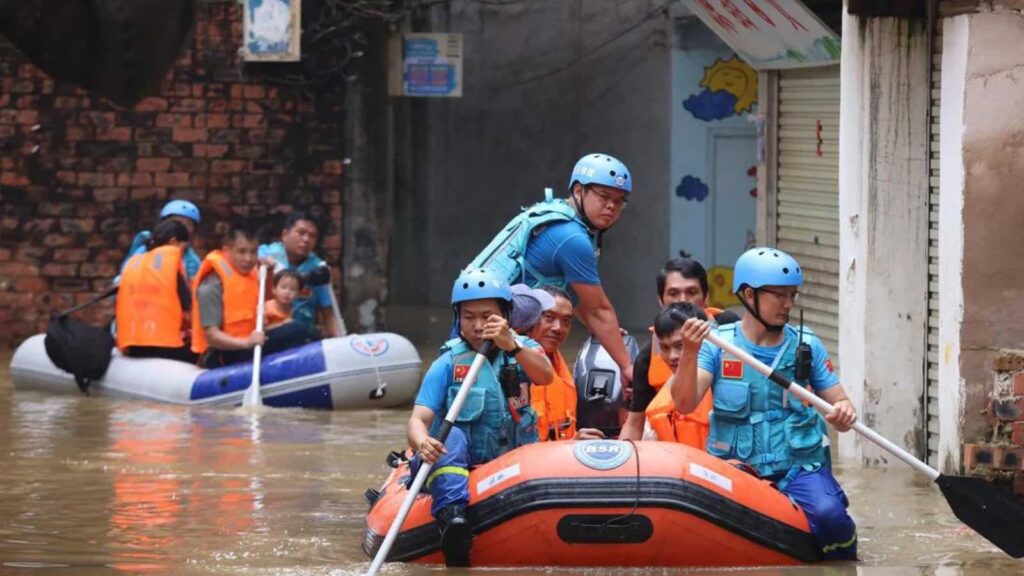The devastation wrought by Bebinca and Yagi serves as a stark reminder of the urgent need for international cooperation and stronger climate action to protect vulnerable populations from the growing threats posed by a warming world.
The bustling financial hub of Shanghai was brought to a near standstill as Typhoon Bebinca, the strongest storm to hit the city in more than seven decades, made landfall on Monday. With wind speeds reaching 151 kph (94 mph), the Category 1 storm struck Shanghai at 7:30 a.m., forcing over 400,000 people to evacuate and felling more than 10,000 trees across the city.
RELEVANT SUSTAINABLE GOALS



Shanghai Faces Worst Typhoon Since 1949
State media reported that the storm, the most powerful since Typhoon Gloria in 1949, resulted in the cancellation of more than 1,400 flights and 570 passenger trains, disrupting travel plans for many during the Mid-Autumn Festival holiday. Four districts in Shanghai raised their weather alerts to the highest level, prompting the closure of parks, businesses, and major resorts, including Shanghai Disney Resort.
Despite the extensive disruptions, only one injury was reported by early afternoon, as over 56,000 rescue workers were deployed to manage the crisis. The eye of the storm moved on to Jiangsu province by midday, but heavy rains continued to lash Shanghai, raising concerns about further disruptions in one of China’s key economic centers.
Super Typhoon Yagi’s Trail of Destruction in Vietnam and Thailand
Meanwhile, Super Typhoon Yagi, Asia’s most powerful storm this year, wreaked havoc across Vietnam and Thailand, leaving a devastating impact in its wake. After intensifying over China’s Hainan Island, Yagi made landfall in Vietnam’s Quang Ninh province and Hai Phong City on September 7, with winds exceeding 200 kph (124 mph).
The Category 4 storm unleashed torrential rains, flash floods, and landslides, forcing more than 50,000 people to evacuate their homes. Nearly 190,000 homes were reported flooded, damaged, or destroyed, and at least 325 people were dead or missing as of the latest reports. The Vietnam Red Cross Society has mobilized relief efforts, including distributing food, medicine, and cash aid, while also assisting with cleanup operations and providing psychological support to those affected.
Despite weakening into a tropical depression, Yagi continues to bring heavy rains and flooding across 26 provinces in Vietnam, including the capital city of Hanoi. The storm’s impact has been severe, with ongoing power outages, disrupted communication networks, and damaged infrastructure compounding the difficulties faced by affected communities.
In neighboring Thailand, the effects of Yagi have also been devastating. Northern provinces, including Chiang Rai, have been submerged, making rescue efforts difficult. The storm’s impact has contributed to the deaths of at least 33 people across Thailand due to rain-related incidents, adding to the broader toll of the storm as it swept across Southeast Asia.
A Growing Threat of More Intense Storms
Typhoon Bebinca and Super Typhoon Yagi underscore the increasing severity of storms fueled by warming ocean temperatures—a trend scientists have long warned about. As extreme weather events become more frequent and intense, the human and economic toll on developing nations, particularly in Southeast Asia, is set to rise.
In Vietnam, the death toll from Yagi and its aftermath has risen to at least 226, with widespread damage to homes, infrastructure, and farms. Videos captured earlier this week showed the dramatic collapse of a steel bridge over the swollen Red River in Phu Tho province, plunging drivers into the raging waters below.
The storms have also reignited discussions on the unequal impacts of climate change. While developed nations bear greater historical responsibility for greenhouse gas emissions, it is the developing countries and small-island states that are suffering the worst consequences.
Lead image courtesy of Huang Yun/VCG/Getty Images (Emergency crews evacuate villages in rubber boats as floodwaters along the Yongjiang River surged in Nanning, Guangxi Zhuang Autonomous Region of China.)
You may also be interested in :
As Climate Disasters Surge, Early Warning Systems Become Essential




